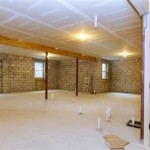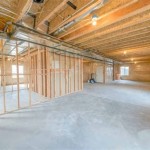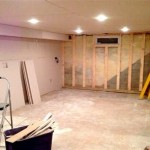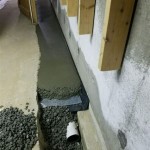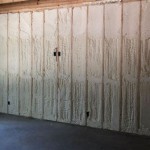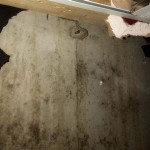```html
How Do You Get Water Out Of Your Basement?
Basement water intrusion is a common problem faced by homeowners, potentially leading to structural damage, mold growth, and compromised indoor air quality. Addressing water in a basement promptly and effectively is crucial to mitigating these risks and maintaining a healthy and structurally sound home. The methods employed to remove water and prevent future occurrences vary depending on the source and severity of the problem. This article outlines common strategies for extracting water from a basement and implementing preventative measures.
Identifying the Source of the Water
Before initiating any water removal efforts, it is essential to accurately identify the source of the water intrusion. This diagnosis informs the selection of appropriate remedial actions and helps prevent recurrence. Several potential sources should be considered, each requiring a specific approach for resolution.
One common source is rainwater runoff. Inadequate grading around the foundation can cause water to pool near the basement walls, eventually seeping through cracks or porous materials. Similarly, clogged or improperly functioning gutters and downspouts can overwhelm the drainage system, directing water towards the foundation. Overflowing gutters allow rainwater to cascade down the side of the house, saturating the soil near the foundation.
Another potential source is groundwater. A high water table, particularly in areas with poor soil drainage, can exert hydrostatic pressure on the basement walls and floor. This pressure forces water through cracks and joints, leading to persistent dampness and water accumulation. Seasonal fluctuations in groundwater levels further exacerbate this problem.
Plumbing leaks are also frequent culprits. Leaky pipes, malfunctioning water heaters, or overflowing washing machines can introduce significant amounts of water into the basement. Regularly inspecting plumbing fixtures and appliances for signs of leaks is crucial for early detection and prevention.
Condensation can also contribute to basement dampness, especially in poorly ventilated areas. Warm, moist air entering the basement condenses on cool surfaces, such as concrete walls and floors. This condensation can create a favorable environment for mold growth and contribute to a musty odor.
Finally, foundation cracks, regardless of their size, provide pathways for water to enter the basement. These cracks can result from settling, soil movement, or hydrostatic pressure. Addressing foundation cracks promptly is essential to prevent further water intrusion and structural damage.
Methods for Water Removal
The specific methods for removing water from a basement depend on the volume of water present and the source of the intrusion. Several techniques are commonly employed, ranging from simple manual removal to sophisticated pumping systems.
For small amounts of water, such as puddles or minor leaks, manual removal with buckets, mops, and towels may suffice. This approach is suitable for addressing temporary leaks or condensation issues. However, it is not effective for dealing with significant water accumulation or ongoing water intrusion.
Wet/dry vacuums are useful for extracting larger volumes of water from carpets, floors, and other surfaces. These vacuums are designed to handle both wet and dry materials, making them ideal for cleaning up after minor floods or leaks. It is crucial to empty the vacuum frequently to prevent overflow and potential damage to the motor.
Sump pumps are essential for basements prone to flooding or high water tables. A sump pump is a submersible pump installed in a sump pit, which is a hole dug in the basement floor. As water accumulates in the sump pit, the pump automatically activates and discharges the water away from the foundation, preventing it from flooding the basement. The pump operates based on a float switch that responds to water level.
Different types of sump pumps exist, including pedestal pumps and submersible pumps. Pedestal pumps are less expensive, but they are also noisier and more prone to clogging. Submersible pumps are more expensive but quieter and more reliable. It is crucial to select a pump with adequate pumping capacity to handle the anticipated water volume.
Water damage restoration services offer professional water extraction and drying services using specialized equipment, such as industrial-strength pumps, dehumidifiers, and air movers. These services are particularly valuable for dealing with significant flooding or water damage resulting from burst pipes or natural disasters. Professionals can quickly and efficiently remove water, dry affected areas, and prevent mold growth.
Preventative Measures to Minimize Water Intrusion
Preventing water intrusion in the first place is the most effective way to protect a basement from water damage. Implementing several preventative measures can significantly reduce the risk of flooding and dampness.
Proper grading around the foundation is essential for directing water away from the house. The ground should slope away from the foundation at a rate of at least six inches over the first ten feet. This slope ensures that rainwater runoff flows away from the basement walls, preventing it from pooling and seeping into the foundation.
Maintaining gutters and downspouts is crucial for effective water management. Gutters should be cleaned regularly to remove leaves, twigs, and other debris that can clog them. Downspouts should be extended away from the foundation to direct water away from the basement walls. Downspout extensions prevent water from accumulating near the foundation and saturating the soil.
Sealing foundation cracks is essential to prevent water from entering the basement. Small cracks can be filled with epoxy or polyurethane caulk. Larger cracks may require professional repair using hydraulic cement or other specialized materials. Addressing cracks promptly prevents them from expanding and allowing more water to enter.
Installing a waterproofing membrane on the exterior of the foundation walls can provide an effective barrier against water intrusion. This membrane prevents water from seeping through the foundation walls and into the basement. A waterproofing membrane is particularly useful in areas with high water tables or poor soil drainage. Professional installation is often recommended to ensure proper application and effectiveness.
Improving ventilation in the basement can help reduce condensation. Installing a dehumidifier can remove excess moisture from the air, preventing condensation from forming on cool surfaces. Opening windows and doors when weather permits can also improve ventilation. Adequate ventilation reduces humidity levels and minimizes the risk of mold growth.
Consider installing an interior drainage system. These systems collect water that seeps through basement walls and floors and directs it to a sump pump. Interior drainage systems are often used in conjunction with waterproofing membranes to provide comprehensive water management. A professional assessment can determine if an interior drainage system is necessary.
Regularly inspecting plumbing fixtures and appliances for leaks can help prevent significant water damage. Check under sinks, behind toilets, and around water heaters for any signs of leaks. Repairing leaks promptly can prevent them from escalating into larger problems. Performing regular inspections can identify and address potential leaks before they cause significant damage.
Consider installing a backwater valve on the main sewer line. This valve prevents sewage from backing up into the basement during heavy rains or sewer system overflows. A backwater valve is particularly important in areas with a history of sewer backups.
By addressing the source of water intrusion, implementing effective water removal methods, and taking preventative measures, homeowners can protect their basements from water damage and maintain a healthy and structurally sound home. Regular maintenance and prompt attention to potential problems are crucial for long-term prevention.
```
7 Key Tips To Keep Water Out Of Your Basement Puroclean Property Damage Restoration

3 Step Clean Up Plan After Your Basement Floods Waterproof Com

Tips For Handling Water In Your Basement Zoeller At Home

How Did Water Get In My Basement Acm Waterproofing

Conseils Pour Garder L Eau Hors De Votre Sous Sol

Pumping Water Out Of Your Basement After A Flood Pump Solutions Australasia

Water In Your Basement What To Do And Who Call Forbes Home

Water In Your Basement What Caused It To Do And How Stop The Sump Pump Co

Fast And Effective Ways To Dry A Basement After Flood Wikihow

Water In The Basement What To Do Causes Prevention
